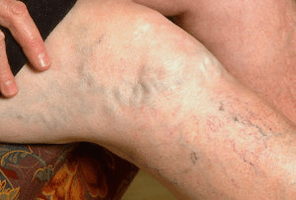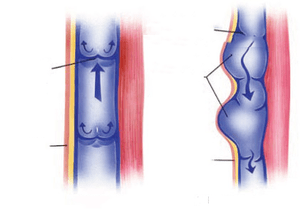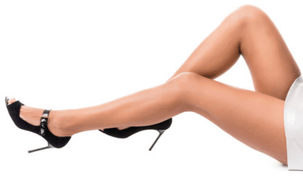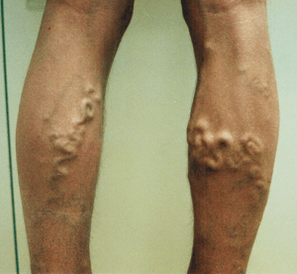
Varicose veins in the legs are a chronic disease. Causes of varicose veins can be hereditary factors, passive lifestyle, high load on the legs and blood vessels. Varicose veins are common during pregnancy.
In pregnant women, the load on the legs increases, edema often occurs, and against this background, blood clots and other vascular problems can occur, which leads to varicose veins.
At the first symptoms of varicose veins (swollen veins, venous mesh in the legs, severe swelling of the legs, pain in the legs and feet) you should consult a phlebologist. A thorough examination will be required to determine the diagnosis and degree of varicose veins. After receiving the necessary information, the doctor will tell you how to treat varicose veins in the legs, prescribe the necessary medications and procedures.
Which specialist treats varicose veins?
When varicose veins expand, many patients do not know which doctor treats varicose veins? All vascular diseases are treated by a phlebologist. A phlebologist is a narrow medical specialty that covers the diagnosis and treatment of vascular diseases.
Of course, a phlebologist should not be visited at a stage where varicose veins are advanced. It is advisable to have an individual phlebologist who can see the development of venous diseases at an early stage and prescribe treatment.
If you have varicose veins, it is advisable to contact a vascular specialist - phlebologist.
Varicose veins treatment methods

Varicose veins are one of the most unpleasant and dangerous diseases for the effective treatment of various diseases. How to treat varicose veins? Varicose veins can be treated by choosing one of several methods.
Treatment of varicose veins depends on the severity of the disease and the individual characteristics of the human body. The procedure for treating varicose veins should be agreed with a doctor. The following effective methods can be distinguished between the methods of combating vascular diseases in the legs:
Sclerotherapy
The essence of this technique is that a special substance (sclerosant) is injected into the patient's veins using a fine needle.
A sclerosant that enters a vein causes the walls to stick together and the affected vein to be removed from the network of common blood vessels in the legs.
Sclerotherapy helps to remove small varicose veins in 3-5 weeks, and large varicose veins and bumps will disappear in three months.
Surgical removal of blood vessels (phlebectomy)
This technique is used for severe neglect of varicose veins. Surgery is performed when varicose veins cause large nodules and seals to form in the veins and cause giant blood clots to appear. An important disadvantage of surgery for varicose veins is the scars and scars on the skin.
Laser therapy for varicose veins is used as a convenient and completely painless method to combat varicose veins. The laser works on the same principle as the sclerotherapy procedure in the affected vessel. The walls of the blood vessels under the influence of the laser beam are soldered, but it will take a long time to effectively treat varicose veins. The advantage of laser therapy for varicose veins is the absence of scars on the skin.
Hirudotherapy or treatment of varicose veins with leech. Leech for varicose veins is often used by supporters of natural medicine. This does not mean that hirudotherapy techniques are effective, but they have many disadvantages. To get a noticeable effect from hirudotherapy, you need to take several courses, each with 8 sessions. Treatment of varicose veins with leech can be effective only in the early stages of vascular disease.
Prevention of varicose veins
Varicose veins begin to manifest as severe or episodic pain in the legs, the appearance of vascular mesh in the skin of the legs, and a blue protruding veins.
It is advisable to warn varicose veins in advance, then look for different ways to treat it. Here are some steps you can take to prevent the development of varicose veins.
- Do not wear high-heeled shoes that are narrow or uncomfortable. The pressure from the uncomfortable shoes in the leg veins increases, which leads to blood clots and the development of varicose veins.
- Regular exercise can help prevent varicose veins. It is advisable to take time every day to walk, run, dance, swim. Varicose veins most often develop in salesmen, hairdressers, stewardesses. Why is this trend observed? During the day, the feet of such professionals receive a large static load as a result of prolonged standing. The result is the development of varicose veins.
- Body weight should be constantly monitored, because it is an extra pound that increases the load on the arteries of the legs and increases blood pressure in the walls.
- It is recommended that you regularly organize barefoot walking on various rough surfaces (gravel, sand, dry grass). In this way, it achieves an effective toning of the arteries in the legs, and at the same time relaxes the muscles of the legs and rests well.
- Don't eat salty and spicy foods and alcohol often. All spicy and salty foods contribute to the formation of blood clots and the development of varicose veins. You can thin the thick blood with plain water or unsalted tomato juice.
- Varicose veins often lead to the development of an unpleasant phenomenon such as cellulite. How to treat cellulite with varicose veins? For a patient with varicose veins, a number of procedures are contraindicated to effectively combat cellulite. Therefore, the doctor should choose an individual treatment plan for varicose veins, which will show you how to deal with the resulting cellulite. With varicose veins, a limited number of procedures aimed at eliminating the symptoms of cellulite are allowed. These treatments include blue clay foot bends, contrasting water treatments, swimming and brisk walking. With varicose veins, exposure to high temperatures in the affected areas of the legs is highly undesirable. For this reason, it is necessary to give up thermal coatings in the fight against cellulite. You can not visit the bath and sauna with varicose veins, you can go to the solarium, you can massage the affected areas of the legs with swollen veins. Power loads with varicose veins are contraindicated. For this reason, people suffering from varicose veins will not be able to get rid of cellulite with heavy strain.
Varicose veins - when to see a doctor?
The first symptoms of early varicose veins should already be a signal to visit a medical professional. The main signs of the development of varicose veins are:
- Heavy heaviness and fatigue in the legs, swelling of the legs.
- Night cramps in calf muscles.
- Burning and pain attacks in the legs.
- Vascular distance
- Appearance of small spider veins or large swollen veins on the surface of the skin.
Varicose veins can only be in the lower extremities. Varicose veins of the lower pelvis, varicose veins of the uterus, varicose veins of the esophagus or genitals are also known. With the development of one of these types of varicose veins, the following symptoms appear:
- Severe pain in the lower abdomen
- Swollen Inguinal Veins
- Unpleasant discharge from the genitals
- Pain during sex
- Increased sacrum and back pain as menstruation begins
- Menstrual disorders, prolonged menstruation with stained discharge.
These symptoms are not specific and may indicate other diseases. In any case, if you suspect varicose veins, it is better to consult an authorized specialist who will make an accurate diagnosis and prescribe the necessary procedures.
Diagnosis of varicose veins

Diagnostic measures to determine the degree of varicose veins are carried out by the doctor from the moment the patient applies. If the initial stage of varicose veins is diagnosed, treatment will be conservative. For this reason, if you suspect varicose veins, you should not delay seeing a doctor.
Various varicose veins are thoroughly examined using laboratory and hardware methods for an accurate diagnosis and the degree of complication. The patient must undergo the necessary tests and undergo a number of procedures to conduct clinical and laboratory studies.
In particular, triplex ultrasound, ultrasound dopplerography of blood vessels, minimally invasive assessment of venous blood flow should be performed. For a correct diagnosis, you need a vascular radiograph (a special procedure in which a radiopaque contrast agent is injected into a vein that causes the disease) to examine the pressure in the blood vessels over time.
Based on the results, the phlebologist gives a comprehensive conclusion about the presence of varicose veins to one degree or another.
Traditional medicine for varicose veins
Varicose veins are a common disease that, in most cases, cannot be treated with traditional medicines.
Varicose veins often occur in pregnant women who do not need to take strong medications.
Therefore, the treatment of varicose veins at home using proven traditional medicine is increasingly used.

- With varicose veins, a decoction of hop cones, which you need to drink a glass three times a day, helps. Chopped hop cones (1 tablespoon) should be poured with boiling water and insist a little.
- Apple cider vinegar is used both externally and internally for the treatment of varicose veins. For apple cider vinegar diluted with a tablespoon of water per day. Areas of the legs affected by varicose veins, if there are no lesions or ulcers on the skin, rubbed with pure apple cider vinegar.
- Before going to bed, you can apply grated raw potatoes or finely chopped green tomatoes to swollen veins and bumps.
- You can prepare a special ointment from the collection of herbs for the treatment of varicose veins with folk remedies. You should take a teaspoon of chamomile, St. John's wort, chicory, coltsfoot and grass dried herbs. The whole plant collection is poured with 1 ml of water and placed on the wood until boiling. After boiling, you need to add badger oil to the composition. For a week, the ointment should be applied to the areas of the legs with swollen veins, the legs should be wrapped in plastic wrap.
Treatment with folk remedies does not always have a lasting effect on varicose veins, but rather tones the veins and leg veins. Alternative treatment of varicose veins can be used in the absence of drug treatment options.
By following a proper diet and engaging in regular physical activity, you can reduce your risk of developing varicose veins. Varicose veins can be completely treated with surgery performed after a thorough examination by a phlebologist.













































